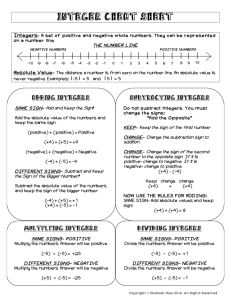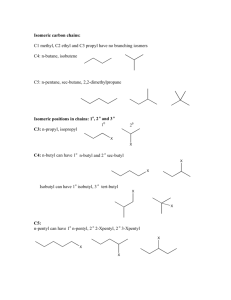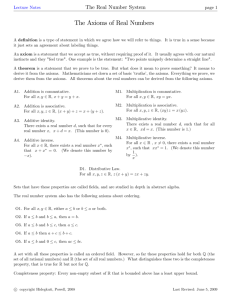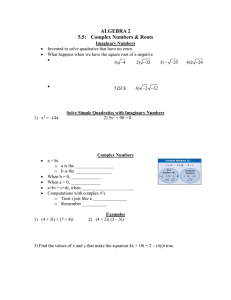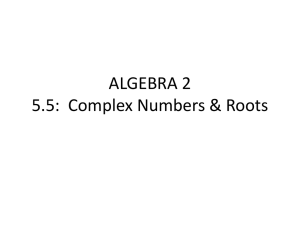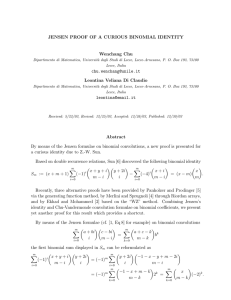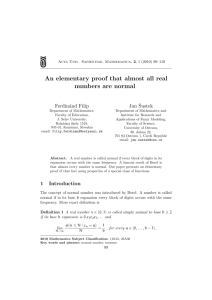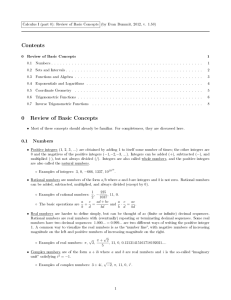INTEGERS 14 (2014) #A51 MULTI-POLY-BERNOULLI-STAR NUMBERS AND FINITE MULTIPLE ZETA-STAR VALUES
advertisement
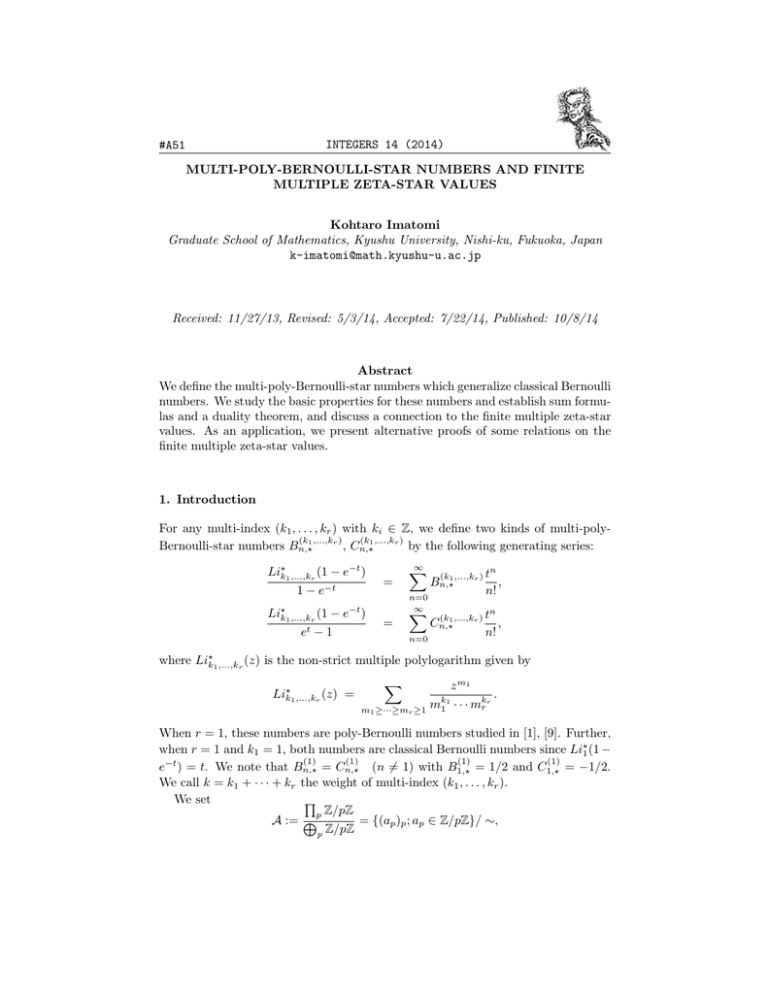
INTEGERS 14 (2014)
#A51
MULTI-POLY-BERNOULLI-STAR NUMBERS AND FINITE
MULTIPLE ZETA-STAR VALUES
Kohtaro Imatomi
Graduate School of Mathematics, Kyushu University, Nishi-ku, Fukuoka, Japan
k-imatomi@math.kyushu-u.ac.jp
Received: 11/27/13, Revised: 5/3/14, Accepted: 7/22/14, Published: 10/8/14
Abstract
We define the multi-poly-Bernoulli-star numbers which generalize classical Bernoulli
numbers. We study the basic properties for these numbers and establish sum formulas and a duality theorem, and discuss a connection to the finite multiple zeta-star
values. As an application, we present alternative proofs of some relations on the
finite multiple zeta-star values.
1. Introduction
For any multi-index (k1 , . . . , kr ) with ki 2 Z, we define two kinds of multi-poly(k ,...,kr )
(k ,...,kr )
Bernoulli-star numbers Bn,?1
, Cn,?1
by the following generating series:
Li?k1 ,...,kr (1
1 e
e t)
t
Li?k1 ,...,kr (1 e t )
et 1
=
=
1
X
n=0
1
X
n=0
n
(k ,...,kr ) t
Bn,?1
n!
n
(k ,...,kr ) t
Cn,?1
n!
,
,
where Li?k1 ,...,kr (z) is the non-strict multiple polylogarithm given by
Li?k1 ,...,kr (z) =
X
m1 ··· mr
z m1
.
mk11 · · · mkr r
1
When r = 1, these numbers are poly-Bernoulli numbers studied in [1], [9]. Further,
when r = 1 and k1 = 1, both numbers are classical Bernoulli numbers since Li?1 (1
(1)
(1)
(1)
(1)
e t ) = t. We note that Bn,? = Cn,? (n 6= 1) with B1,? = 1/2 and C1,? = 1/2.
We call k = k1 + · · · + kr the weight of multi-index (k1 , . . . , kr ).
We set
Q
p Z/pZ
A := L
= {(ap )p ; ap 2 Z/pZ}/ ⇠,
p Z/pZ
2
INTEGERS: 14 (2014)
where (ap )p ⇠ (bp )p is equivalent to the equalities ap = bp for all but finitely many
primes p. The finite multiple zeta-star values are defined by
?
⇣A
(k1 , . . . , kr ) := Hp? (k1 , . . . , kr ) mod p
p
2 A,
where Hn? (k1 , . . . , kr ) is the non-strict multiple harmonic sum defined by
Hn? (k1 , . . . , kr ) =
X
n 1 m1 ··· mr
1
.
k1
m
·
· · mkr r
1
1
For more details on the finite multiple zeta(-star) values, we refer the reader to [7],
[10] and [12]. We use “star” to indicate that the inequalities in the sum are nonstrict in contrast to the strict ones usually adopted in the references above. Each
of these is expressed as a linear combination of the other.
This article is organized as follows. In §2, we give fundamental properties for
the multi-poly-Bernoulli-star numbers. In §3, we describe the sum formula and the
duality relation for the multi-poly-Bernoulli-star numbers. In §4, we study connections between the finite multiple zeta-star values and the multi-poly-Bernoulli-star
numbers. As a result, we obtain alternative proofs of some relations for the finite
multiple zeta-star values.
2. Basic Properties for the Multi-Poly-Bernoulli-Star Numbers
In this section, we introduce basic results for the multi-poly-Bernoulli-star numbers. We first give the recurrence relations for the multi-poly-Bernoulli-star num(k ,...,kr )
(k ,...,kr )
bers Bn,?1
, Cn,?1
. Before stating them, we provide the following identity
for the non-strict multiple polylogarithm, whose proof is straightforward and is
omitted.
Lemma 2.1. For any multi-index (k1 , . . . , kr ) with ki 2 Z, we have
8 1
>
Li?
(t)
(k1 6= 1),
>
>
>
t k1 1,k2 ,...,kr
<
1
d ?
Li?
(t) (k1 = 1, r 6= 1),
Li
(t) =
t(1
t) k2 ,...,kr
>
dt k1 ,...,kr
>
>
>
: 1
(k1 = r = 1).
1 t
Proposition 2.1. For any multi-index (k1 , . . . , kr ), we have the following recursions:
3
INTEGERS: 14 (2014)
(i) When k1 6= 1,
(k ,...,kr )
=
(k ,...,kr )
=
Bn,?1
Cn,?1
(ii) When k1 = 1,
(1,k ,...,kr )
=
(1,k ,...,kr )
=
Bn,? 2
Cn,? 2
0
1 @ (k1
Bn,?
n+1
0
1 @ (k1
Cn,?
n+1
1,k2 ,...,kr )
1,k2 ,...,kr )
1
◆
n
(k ,...,kr ) A
Bj,?1
,
j
1
j=1
1
n
X1 ✓n + 1◆ (k ,...,k )
r A
Cj,?1
.
j
j=0
n
X1 ✓
0
1
◆
n ✓ ◆
n
1✓
X
X
1 @
n
n
(k ,...,kr )
(1,k ,...,kr ) A
Bj,?2
Bj,? 2
,
n + 1 j=0 j
j
1
j=1
0
1
✓
◆
n
1
X
1 @ (k2 ,...,kr )
n
(1,k ,...,kr ) A
Cn,?
( 1)n j
Cj,? 2
,
n+1
j
1
j=1
where an empty sum is understood to be 0.
(k ,...,kr )
Proof. We prove the relations for Bn,?1
Li?k1 ,...,kr (1
e t ) = (1
(k ,...,kr )
: those for Cn,?1
e t)
1
X
n
(k ,...,kr ) t
Bn,?1
n!
n=0
are similar.
.
(1)
We di↵erentiate both sides of (1): When k1 6= 1, we obtain
(LHS) =
e
1
(RHS) = e
t
t
e t
1
X
Li?k1
1,k2 ,...,kr (1
n
(k ,...,kr ) t
Bn,?1
n=0
So we have
1 ⇣
X
(k
Bn,?1
n=0
1,k2 ,...,kr )
(k ,...,kr )
Bn,?1
n!
⌘ tn
n!
+ (1
e t ),
e t)
1
X
n
(k ,...,kr ) t
1
Bn+1,?
n=0
= (et
1)
1
X
n!
.
n
(k ,...,kr ) t
1
Bn+1,?
n!
n=0
✓
◆
1 n
n
X
X1 n
(k1 ,...,kr ) t
=
Bj+1,?
.
j
n!
n=1 j=0
Comparing the coefficients of tn /n! on both sides, we obtain (i). When k1 = 1,
1
Li?
(1 e t ),
1 e t k2 ,...,kr
1
1 ⇣
n
X
X
(1,k2 ,...,kr ) t
(1,k ,...,kr )
(RHS) =
Bn+1,?
+e t
Bn,? 2
n!
n=0
n=0
(LHS) =
(1,k ,...,kr )
2
Bn+1,?
⌘ tn
n!
.
4
INTEGERS: 14 (2014)
So we have
1 ⇣
X
(1,k ,...,kr )
Bn,? 2
(1,k2 ,...,kr )
Bn+1,?
n=0
⌘ tn
n!
1 ⇣
X
(k ,...,kr )
= e
Bn,?2
(1,k ,...,kr )
t
=
2
Bn+1,?
n=0
1 X
n ✓
X
n=0 j=0
◆
n ⇣ (k2 ,...,kr )
Bj,?
j
⌘ tn
n!
(1,k ,...,kr )
2
Bj+1,?
⌘ tn
n!
and by this we obtain (ii).
We proceed to describe explicit formulas for the multi-poly-Bernoulli-star numbers in terms of the Stirling numbers of the second
kind. We recall that the Stirling
⇢
n
numbers of the second kind are the integers
for all integers m, n satisfying
m
the following recursions and the initial values:
⇢
⇢
⇢
n+1
n
n
=
+m
(8n, m 2 Z),
m
m 1
m
⇢
⇢
⇢
0
n
0
= 1,
=
= 0 (n, m 6= 0).
0
0
m
Proposition 2.2. For any multi-index (k1 , . . . , kr ), ki 2 Z, we have
⇢
X
( 1)m1 +n 1 (m1 1)!
n
(k1 ,...,kr )
Bn,?
=
k1
kr
m
1
m1 · · · mr
1
n+1 m1 ··· mr 1
and
(k ,...,kr )
Cn,?1
X
=
n+1 m1 ··· mr
⇢
1)! n + 1
.
m1
( 1)m1 +n 1 (m1
mk11 · · · mkr r
1
Proof. Using the following identity (cf. [3, eqn. 7.49])
1 ⇢
X
j tj
t
m
(e
1) = m!
(m
m j!
j=m
0),
(2)
we have
1
X
=
n=0
Li?k1 ,...,kr (1
=
m1
=
n
(k ,...,kr ) t
Bn,?1
n!
e t)
1 e t
X
(1 e t )m1 1
mk11 · · · mkr r
··· mr 1
X
1
X
m1 ··· mr 1 j=m1
( 1)m1 +j 1 (m1
mk11 · · · mkr r
1
1)!
⇢
j
m1
tj
1 j!
5
INTEGERS: 14 (2014)
=
1
X
X
j=0 j+1 m1 ··· mr
( 1)m1 +j 1 (m1
mk11 · · · mkr r
1
1)!
⇢
j
m1
tj
.
1 j!
Thus comparing the coefficients of tn /n! on both sides, we obtain the explicit for(k ,...,kr )
mula for Bn,?1
.
(k ,...,kr )
The explicit formula for Cn,?1
is obtained similarly by using the identity
⇢
1
X
e t (1 e t )m 1
j + 1 tj
=
( 1)j+m+1
,
(m 1)!
m
j!
j=m 1
which follows from (2) by di↵erentiation.
We finish this section by giving some simple relations among the multi-polyBernoulli-star numbers.
Proposition 2.3. For any multi-index (k1 , . . . , kr ) with ki 2 Z, we have
n ✓ ◆
X
n
(k1 ,...,kr )
(k ,...,kr )
Bn,?
=
Cj,?1
j
j=0
and
(k ,...,kr )
Cn,?1
n
X
=
( 1)n
j
j=0
(k ,...,kr )
Proof. The generating functions of Bn,?1
the above identities follow immediately.
✓ ◆
n
(k ,...,kr )
Bj,?1
.
j
(k ,...,kr )
, Cn,?1
di↵er by the factor et , and
Proposition 2.4. For any multi-index (k1 , . . . , kr ), we have
(k ,...,kr )
Cn,?1
(k ,...,kr )
= Bn,?1
(k ,...,kr )
Proof. By the explicit formula for Cn,?1
(k ,...,kr )
Cn,?1
( 1)m1 +n 1 (m1
mk11 · · · mkr r
1
n+1 m1 ··· mr
X
=
n+1 m1 ··· mr
+
X
, we obtain
⇢
1)! n + 1
m1
⇢
m1 +n 1
( 1)
(m1 1)!
n
k1
kr
m1 1
m1 · · · mr
1
⇢
( 1)m1 +n 1 (m1 1)! n
m1
mk11 1 mk22 · · · mkr r
X
=
(k1 1,k2 ,...,kr )
.
1,?
Cn
n+1 m1 ··· mr 1
(k ,...,kr )
= Bn,?1
(k1 1,k2 ,...,kr )
.
1,?
Cn
The second equality above is by the recursion for the Stirling numbers of the second
kind.
6
INTEGERS: 14 (2014)
3. Main Results
We give the following sum formulas for multi-poly-Bernoulli-star numbers.
Theorem 3.1. We have
(k ,...,kr )
=
✓
◆
( 1)k
n
(1)
B
k
k 1 n k+1,?
(3)
(k ,...,kr )
=
✓
◆
( 1)k
n
(1)
C
.
k
k 1 n k+1,?
(4)
X
( 1)r Bn,?1
X
( 1)r Cn,?1
k1 +···+kr =k
1rk,ki 1
and
k1 +···+kr =k
1rk,ki 1
Proof. We multiply both sides of (3) by tn /n! and sums on n. Hence we have
1
X
(LHS) =
X
n
(k ,...,kr ) t
( 1)r Bn,?1
n!
n=0 k1 +···+kr =k
1rk,ki 1
X
=
( 1)r
k1 +···+kr =k
1rk,ki 1
(RHS) =
=
=
=
Li?k1 ,...,kr (1
1 e
e t)
t
,
◆
1 ✓
( 1)k X
n
tn
(1)
Bn k+1,?
k n=0 k 1
n!
1
( 1)k X (1)
B
k! n=0 n k+1,? (n
1
( 1)k X (1) tn+k
Bn,?
k! n=0
n!
( 1)k tk
k! 1 e
t
tn
k + 1)!
1
.
Since both sides have the same denominator, it suffices to prove the following identity:
X
k1 +···+kr =k
1rk,ki 1
( 1)r Li?k1 ,...,kr (1
e t) =
( 1)k k
t .
k!
(5)
This equality is proved by induction on the weight. When k = 1, the left-hand side
is Li?1 (1 e t ) = t and is equal to the right-hand side. Next we assume the
7
INTEGERS: 14 (2014)
identity holds when the weight is k. Then by di↵erentiating the left-hand side of
the identity of weight k + 1, we obtain
0
X
d B
B
dt @
1
C
e t )C
A
( 1)r Li?k1 ,...,kr (1
k1 +···+kr =k+1
1rk+1,ki 1
=
X
( 1)r
k1 +···+kr =k
1rk,ki 1
=
X
✓
e
1
t
e
t
1
1 e
( 1)r+1 Li?k1 ,...,kr (1
◆
t
Li?k1 ,...,kr (1
e t)
e t)
k1 +···+kr =k
1rk,ki 1
=
( 1)k+1 k
t .
k!
We used the induction hypothesis in the last equality. Therefore we have
X
( 1)r Li?k1 ,...,kr (1
e t) =
k1 +···+kr =k+1
1rk+1,ki 1
( 1)k+1 k+1
t
+C
(k + 1)!
with some constant C, which we find is 0 by putting t = 0. The equation (4) follows
from (5) since the generating function of Cn,? di↵ers from that of Bn,? only by a
factor e t .
Next we describe the duality relation for the multi-poly-Bernoulli-star numbers.
We recall the duality operation of Ho↵man [6, p. 65]. We define a function S from
the set of multi-indices (k1 , . . . , kr ) with ki
1 and weight k to the power set of
{1, 2, . . . , k 1} by
S((k1 , . . . , kr )) = {k1 , k1 + k2 , . . . , k1 + · · · + kr
1 }.
Obviously, the map S is a one-to-one correspondence. Then (k10 , . . . , kl0 ) is said to
be the dual index for (k1 , . . . , kr ) in Ho↵man’s sense when
(k10 , . . . , kl0 ) = S
1
({1, 2, . . . , k
1}
S((k1 , . . . , kr ))).
It is easy to see that Ho↵man’s duality operation is an involution. Note that k1 > 1
if and only if k10 = 1.
Theorem 3.2. For any multi-index (k1 , . . . , kr ) with ki
(k ,...,kr )
Cn,?1
(k10 ,...,kl0 )
= ( 1)n Bn,?
1(1 i r), we have
,
where (k10 , . . . , kl0 ) is the dual index of (k1 , . . . , kr ) in Ho↵man’s sense.
8
INTEGERS: 14 (2014)
Proof. As in the previous proof, consider the generating functions of both sides:
(LHS) =
(RHS) =
1
X
n
(k ,...,kr ) t
Cn,?1
n=0
1
X
n!
n
( 1)
=
Li?k1 ,...,kr (1 e t )
,
et 1
n
(k0 ,...,kl0 ) t
Bn,?1
n!
n=0
=
Li?k0 ,...,k0 (1
1
l
1
et
et )
.
Hence we have to show the following identity:
Li?k1 ,...,kr (1
e t ) + Li?k10 ,...,k0 (1
et ) = 0.
l
This identity also follows from induction on the weight. First, it is trivial in the
case k = 1. Thus, we assume the above identity holds when the weight is k. Since
0
k1 = 1 is equivalent to k1 6= 1, we may assume k1 = 1 by the symmetry of the
identity. Then when the weight is k + 1, the derivative of the left-hand side yields
⌘
d ⇣ ?
Li1,k2 ,...,kr (1 e t ) + Li?k0 ,...,k0 (1 et )
1
l
dt
t
1
e
=
Li?
(1 e t ) +
Li? 0
et )
0
0 (1
1 e t k2 ,...,kr
1 et k1 1,k2 ,...,kl
⇣
⌘
1
?
t
?
t
=
Li
(1
e
)
+
Li
(1
e
)
0
0
0
k2 ,...,kr
k1 1,k2 ,...,kl
1 e t
= 0.
Therefore we obtain
Li?1,k2 ,...,kr (1
e t ) + Li?k0 ,...,k0 (1
1
et ) = C
l
with some constant C, and by putting t = 0, we conclude C = 0.
4. Connection to the Finite Multiple Zeta-Star Values
In this section, we give alternative proofs for some relations of the finite multiple
zeta-star values using the multi-poly-Bernoulli-star numbers. The following congruence is the “star-version” of the congruence given in [8, Theorem.8], and is proved
in exactly the same manner:
Hp? (k1 , . . . , kr ) ⌘
Thus we find
?
⇣A
(k1 , . . . , kr ) =
⇣
(k1 1,k2 ,...,kr )
2,?
Cp
(k1 1,k2 ,··· ,kr )
2,?
Cp
mod p.
⌘
mod p .
p
(6)
9
INTEGERS: 14 (2014)
Corollary 4.1 (M. Ho↵man [7]). For any multi-index (k1 , . . . , kr ) with ki
0
0
1(1 i r), let (k1 , . . . , kl ) be the dual index for (k1 , . . . , kr ) in Ho↵man’s sense.
Then we have
0
0
?
?
⇣A
(k1 , . . . , kr ) = ⇣A
(k1 , . . . , kl ).
Proof. It is sufficient to prove the case k1 = 1. By (6) and the duality relation for
the multi-poly-Bernoulli-star numbers, we obtain
⇣
⌘
(0,k2 ,··· ,kr )
(LHS) =
Cp 2,?
mod p ,
p
✓
◆
0
0
0
(k1 1,k2 ,··· ,kl )
(RHS) =
Cp 2,?
mod p
p
⇣
⌘
(k ,··· ,k )
=
( 1)p Bp 22,? r mod p .
p
(0,k ,··· ,kr )
Hence we complete the proof if we prove Cn,? 2
consider the generating functions of these numbers:
1
X
n
(0,k ,··· ,kr ) t
Cn,? 2
n!
n=0
Li?0,k2 ,...,kr (1
et 1
=
1
=
et
1
X
m2 ··· mr
(0,k2 ,··· ,kr )
2,?
Cp
for all n. We
e t)
1
k2
m2 · · · mkr r
1
1
=
Li?
(1
e t (et 1) k2 ,...,kr
1
n
X
(k ,··· ,kr ) t
=
Bn,?2
.
n!
n=0
From this we have
(k ,··· ,kr )
= Bn,?2
1
X
(1
e t )m1
m1 =m2
e t)
(k2 ,··· ,kr )
2,?
= ( 1)p Bp
for any odd prime p.
The following corollary is a weaker version of the sum formula for the finite
multiple zeta-star values proved in [11].
Corollary 4.2. We have
X
?
( 1)r ⇣A
(k1 , . . . , kr ) = (Bp
k1 +···+kr =k
r 1,k1 2,ki 1
where Bn is the classical Bernoulli numbers.
k
mod p)p ,
10
INTEGERS: 14 (2014)
Proof. Equations (4) and (6) yield
X
(
k1 +···+kr =k+1
r 1,k1 2,ki 1
?
1)r+1 ⇣A
(k1 , . . . , kr )
=
=
So replacing k by k
✓
⇣
✓
( 1)k p
k
k
(1)
k 1,?
Cp
◆
2
(1)
C
1 p k
1,?
◆
mod p
p
⌘
mod p .
p
1, we obtain the desired identity.
Acknowledgments. The author expresses his sincere gratitude to Professor M.
Kaneko for useful discussions and invaluable advice.
References
[1] T. Arakawa and M. Kaneko, Multiple zeta values, poly-Bernoulli numbers, and related zeta
functions, Nagoya Math. J. 153 (1999), 189–209.
[2] A. Bayad and Y. Hamahata, Multiple Polylogarithms and Multi-Poly-Bernoulli Polynomials,
Funct. Approx. Comment. Math. 46 (2012), 45–61.
[3] R. Graham, D. Knuth, and O. Patashnik, Concrete Mathematics, Addison-Wesley, 1989.
[4] Y. Hamahata and H. Masubuchi, Special Multi-Poly-Bernoulli Numbers, J. Integer Seq. 10,
(2007).
[5] Y. Hamahata and H. Masubuchi, Recurrence Formulae for Multi-Poly-Bernoulli Numbers,
Integers 7 (2007), #A46, 15pp.
[6] M. Ho↵man, Algebraic aspects of multiple zeta values, Zeta functions, Topology and Quantum
Physics, Developments in Math. 14, Springer, New York, 2005, pp. 51–73.
[7] M. Ho↵man, Quasi-symmetric functions and mod p multiple harmonic sums, preprint,
arXiv:math/0401319v2 [math.NT] 17 Aug. 2007.
[8] K. Imatomi, M. Kaneko and E. Takeda, Multi-Poly-Bernoulli Numbers and Finite Multiple
Zeta Values, J. Integer Seq. 17 (2014).
[9] M. Kaneko, Poly-Bernoulli numbers, J. Théor. Nombres Bordeaux 9 (1997), 199–206.
[10] M. Kaneko and D. Zagier, Finite Multiple Zeta Values, preprint.
[11] S. Saito and N. Wakabayashi, Sum formula for finite multiple zeta values, J. Math. Soc.
Japan, to appear.
[12] J. Zhao, Wolstenholme type theorem for multiple harmonic sums, Int. J. Number Theory 4
(2008), 73–106.
